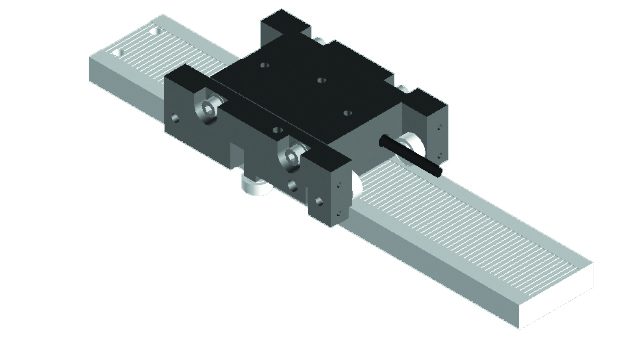Stepper motors go into linear actuators in two different ways:
Stepper motors that are traditional rotary motors couple to mechanical rotary-to-linear motion devices (often in the form of a threaded shaft that mates with traversing nut or carriage) to produce linear motion. In this actuator setup, the motor output shaft usually couples to the screw to turn it … and advance the nut (or carriage) and attached load. These are usually small designs that go into consumer products or small-stroke applications in industrial machines.
In contrast, true linear stepper motors—which this FAQ covers in more depth—function much like linear-motor types but leverage the same mode of operation as rotary stepper motors to produce linear motion. More specifically, traditional linear-stepper motors (using variable-reluctance operation) have a moving carriage called a forcer with a permanent magnet, laminated steel cores (which the manufacturer cuts into teeth) and coils around the laminated cores. This forcer engages a straight and stationary track called a platen. This linear-stepper part is mostly steel bar cores (which the manufacturer cuts into teeth and plates with nickel). For super-long strokes, installers can put multiple platens end-to-end and have the forcer ride on all of them.
Summary of linear stepper motors
Engineers most commonly use these linear actuators in larger installations; on axes that move heavier loads; and in high-end medical or material-handling applications such as pick-and-place machinery that require extremely high precision. Like rotary equivalents, linear stepper motors either use a variable reluctance (just described) or a hybrid mode of operation. A hybrid linear-stepper platen is like that of a variable-reluctance linear stepper. In contrast, the forcer has multiple permanent magnets, magnetic U-shaped cores (with coils around them) and a steel yoke.

Whether run open or closed loop, linear stepper motors output motion with repeatability and resolution. What’s more, linear steppers aren’t subject to wear. Nor does stalling damage them. The attractive force from the magnet preloads the assembly and lets engineers use these in myriad orientations. Linear stepper motors can also use changes in switched excitation (in one more phases) to get precise steps.
Summary of rotary-stepper-driven axes
When engineers use rotary-stepper-driven axes instead of linear stepper motors, they face a different set of design considerations. For starters, the engineer must pick the leadscrew’s lead and pitch. Lead defines the distance a screw thread advances in one revolution. Pitch is the distance between adjacent threads. A small lead with more threads per inch outputs higher force and resolution; large leads (or fewer threads) output lower force but higher speed.
Screws also have their own inertia. In setups where the motor body houses the screw-engaging nut, this inertia increases as the screw extends … which in turn reduces maximum design speed. In fact, it’s fairly common for stepper-driven leadscrews to have embedded drive nuts. Even where the setup takes a more traditional arrangement—with the nut outside the motor, and fixed to rails that bear the loads the axis advances—nut material selection is another design consideration. Engineers must ask: will this axis experience heat and the effects of friction? Plastic exhibits low friction but cannot withstand high heat; bronze nuts resist heat but have a high coefficient of friction.
One final note on rotary-stepper-driven axes: Because these actuators incorporate mechanical components, they exhibit wear and life limitations. That said, when engineers properly size for the load and create a forgiving operating environment (with low humidity, protection from harsh chemicals and dirt, and controlled temperature) rotary-stepper-driven exhibit long life—to millions of cycles.
For more information, read:
Sparkfun’s consumer-grade rotary-stepper-driven actuator for sale
PDF: BSA reference on linear motors
PDF: AMETEK’s Haydon Kerk linear-actuator primer
Google Books: Variable-reluctance linear motors
Google Books: More on linear motors







Leave a Reply
You must be logged in to post a comment.